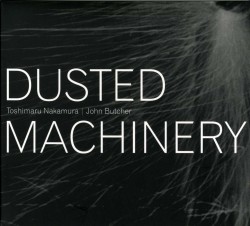 Dusted Machinery
Dusted Machinery
John Butcher; Toshimaru Nakamura
Monotype Records mono 041
www.monotyperecords.com
Classic man versus machine improvisation: British saxophonist John Butcher matches his skills against the distinctive audio feedback produced from a so-called no-input mixing board given near-anthropomorphic cunning through the manipulations of Japan’s Toshimaru Nakamura. By connecting the board’s input to its output, Nakamura’s blurry oscillations evolve in ever-changing textural pitches from grinding croaks to ear-splitting yowls. It’s a tribute to the talents of Butcher that his perceptive reed thrusts and rejoinders evolve as appropriately as they do. Although by the final track he adopts a mechanized strategy by adding feedback loops to his reed playing, on the other pieces Nakamura’s signal processing, oscillations and indistinct mechanical static confront what Butcher can produce only with tongue, lips, mouth, throat and fingers.
On Maku for instance, while motor-driven drones pulsate from thunderously loud to blurry fuzz tones, Butcher’s tenor saxophone sequences involve smears and expansive vibratos so that each Nakamura-originated texture meets a responsive sonic action. Moreover, while the machine’s voltage flanges may be so powerful that they’re nearly visible, the reedist’s multiphonic overblowing produces equivalent timbres that in split seconds leap from dog-whistle-like altissimo to basso growls, and from pianissimo to fortissimo. Overall, Butcher uses flutter-tongued intensity to chip away at the board-created solid sound block.
Using the soprano saxophone on Knead and Nobasu respectively, Butcher’s nasal split-tones, nephritic growls, key percussion and surprisingly lyrical interludes substantiate his human-ness. Conclusively he demonstrates that with original ideas and profound techniques man can lead machine to cooperate in creating a memorable sound program.



